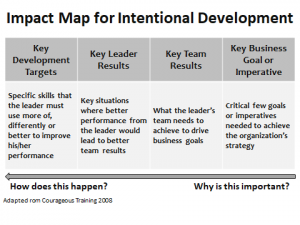
Through People


One factor that we often in find in failing leadership development programs is when companies employ a long , complex list of “key” leadership competencies. On their own, each competency makes sense but, in total, the complexity creates confusion and results in development efforts that don’t have an impact on business results.
Its tough to build a link between a complex web of skills and the strategic intent of the organization. To remedy the situation, we like to emphasize that “You can’t be it until you see it.” The “it” needs to be a few basic, simple development themes, not a long, exhausting list of skills. Research has shown that customizing and personalizing development in this fashion is key to optimizing learning and retention.
One tool we like to use to help learners “see it” is by creating an Impact Map (Thanks to Tim Mooney and Robert Brinkerhoff. Learn more about Impact Maps in their book, Courageous Training). An Impact Map is similar to the Covey concept of beginning-with-the-end-in-mind. You start by identifying the business and unit goals the development intervention is intended to affect. In other words, you describe the business case for the development effort. From there, you cascade the map down through the results the learner must achieve to achieve those business goals. Then, you set the course to the critical few on-the-job actions and competencies the intervention must create.

In other words, you clearly identify the business imperative and then align the intervention to enable the employees to achieve that outcome. Mooney and Brinkerhoff refer to this as creating “a clear ‘Line of Sight’ . . . a step-by-step linkage that connects training and development, job behaviors, and specific results.”
Impact Maps are built from the right (Why is this important?) to the left (How does this happen?) so that the business logic for development is established in a simple, linear format. In application, learners read the Impact Map from left to right. Used in this way, an Impact Map is an excellent tool to create a clear picture of the how and why of development . . . learners can see what they need to be.